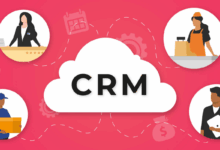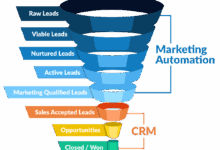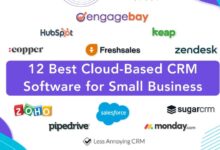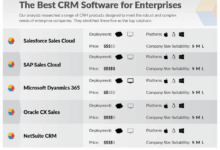CRM Software for Small Business Success
CRM Software for Small Business is more than just software; it’s a strategic investment that can significantly impact growth and profitability. This guide explores how selecting and implementing the right CRM system can streamline operations, improve customer relationships, and ultimately drive revenue for small businesses. We’ll delve into the key features, selection process, implementation strategies, and ways to maximize your return on investment. Understanding the nuances of CRM software is crucial for any small business aiming to thrive in today’s competitive landscape.
From identifying your specific needs and choosing between cloud-based and on-premise solutions, to mastering data security and measuring ROI, this comprehensive guide provides actionable steps to help your small business harness the power of CRM. We’ll cover essential features, integration capabilities, and best practices for a successful implementation. Ultimately, this guide aims to empower small businesses to leverage CRM technology for sustainable growth and enhanced customer satisfaction.
Defining Needs for Small Business CRM
Running a small business is demanding. Juggling multiple tasks, from managing customer interactions to tracking sales and inventory, can quickly become overwhelming. Without the right tools, efficiency suffers, and growth potential is stifled. A Customer Relationship Management (CRM) system can be the solution, streamlining operations and freeing up valuable time for strategic initiatives.
Effective customer relationship management is crucial for small business success. Many small businesses struggle without a centralized system for managing customer interactions, leading to lost opportunities and decreased productivity.
Key Challenges Faced by Small Businesses Without CRM Software
Small businesses often face three significant challenges without a CRM system: disorganized customer data, inefficient communication, and difficulty tracking sales and marketing efforts. These issues directly impact revenue generation, customer satisfaction, and overall business growth.
How CRM Software Addresses These Challenges
CRM software tackles these challenges head-on. It centralizes customer information in one accessible location, improving data organization and accessibility. This eliminates the frustration of searching across multiple spreadsheets or email threads for vital customer details. Furthermore, CRM systems often integrate with communication tools, streamlining interactions and improving response times. Finally, built-in reporting and analytics capabilities provide valuable insights into sales performance and marketing campaign effectiveness, allowing businesses to make data-driven decisions.
Comparison of Basic vs. Advanced CRM Systems
The choice between a basic and an advanced CRM system depends on a small business’s specific needs and budget. Basic systems offer core functionalities, while advanced systems provide more comprehensive features and scalability.
| Feature | Basic CRM | Advanced CRM |
|---|---|---|
| Contact Management | Basic contact storage and organization. | Advanced contact management with segmentation, tagging, and custom fields. |
| Communication Tools | Email integration. | Email integration, call logging, social media integration, and live chat. |
| Sales Pipeline Management | Basic sales pipeline tracking. | Advanced sales pipeline management with forecasting, automation, and reporting. |
| Reporting and Analytics | Basic reporting on key metrics. | Advanced reporting and analytics with customizable dashboards and predictive analytics. |
Top Features of CRM Software for Small Businesses
Choosing the right CRM software can significantly impact a small business’s growth and customer satisfaction. A well-implemented CRM system streamlines operations, improves communication, and ultimately boosts profitability. This section highlights key features to consider when selecting a CRM solution.
Effective CRM software empowers small businesses to manage customer interactions efficiently, leading to increased sales, improved customer loyalty, and a stronger brand reputation. The right features can automate tasks, personalize communications, and provide valuable insights into customer behavior, all contributing to a more successful business.
Essential CRM Features for Small Businesses
Five core features are crucial for any small business CRM system. These features, when implemented effectively, deliver significant returns on investment by optimizing workflow and improving customer relationships.
- Contact Management: A robust contact management system allows for centralized storage and organization of all customer data, including contact details, communication history, and purchase information. This eliminates data silos and ensures everyone in the company has access to a complete customer profile. For example, a florist could track individual customer preferences for flower types and delivery dates, ensuring personalized service.
- Sales Pipeline Management: Visualizing the sales process through a pipeline allows for easy tracking of leads, opportunities, and deals. This feature provides valuable insights into sales performance, identifies bottlenecks, and helps prioritize tasks. A software company, for instance, can monitor the progress of each sales prospect through different stages, from initial contact to closing the deal.
- Customer Interaction Tracking: Recording all customer interactions, including emails, calls, and social media messages, provides a comprehensive view of the customer journey. This history helps personalize future interactions and resolve issues efficiently. A restaurant, for example, can track customer feedback from online reviews and use it to improve their service.
- Reporting and Analytics: Analyzing CRM data provides valuable insights into customer behavior, sales trends, and marketing campaign effectiveness. This data-driven approach helps make informed business decisions and optimize strategies. A clothing retailer could track which marketing campaigns generate the most sales and adjust their strategy accordingly.
- Task and Workflow Automation: Automating repetitive tasks, such as sending follow-up emails or scheduling appointments, frees up valuable time and resources. This increased efficiency allows staff to focus on higher-value activities, improving overall productivity. An insurance broker could automate email reminders for policy renewals, saving time and improving customer retention.
Cloud-Based vs. On-Premise CRM Solutions
The choice between cloud-based and on-premise CRM solutions depends heavily on a small business’s specific needs and resources. Each option presents distinct advantages and disadvantages.
- Cloud-Based CRM:
- Advantages: Accessibility from anywhere with an internet connection, lower upfront costs, automatic updates, scalability.
- Disadvantages: Reliance on internet connectivity, potential security concerns (though reputable providers have robust security measures), monthly subscription fees.
- On-Premise CRM:
- Advantages: Greater control over data security and privacy, no reliance on internet connectivity, potential for customization.
- Disadvantages: Higher upfront costs, ongoing maintenance and IT support required, limited accessibility (typically only within the office network).
Benefits of CRM Integration with Other Business Tools
Integrating the CRM system with other business tools significantly enhances its functionality and value. This integration streamlines workflows and provides a more holistic view of the business.
For example, integrating with email marketing platforms allows for targeted campaigns based on customer segmentation and behavior data within the CRM. Linking with accounting software automates invoicing and payment processing, improving financial management. This synergy reduces manual data entry, minimizes errors, and provides a more comprehensive understanding of the customer journey and its impact on the bottom line.
Choosing the Right CRM System
Selecting the perfect CRM system for your small business can feel overwhelming, given the sheer number of options available. However, a systematic approach focusing on your specific needs and resources can simplify the process and lead to a successful implementation. This section provides a structured guide to help you navigate the selection process effectively.
A Step-by-Step Guide to CRM Selection
Choosing the right CRM involves careful consideration of your budget and business size. A larger business with more complex needs will require a more robust and potentially more expensive system than a smaller startup. The following steps provide a framework for making an informed decision.
- Define Your Budget: Determine a realistic budget for the CRM software, including licensing fees, implementation costs, and potential ongoing maintenance. Consider whether you’ll need a one-time purchase or a subscription model.
- Assess Your Business Needs: Identify your key requirements. Do you need contact management, sales pipeline tracking, marketing automation, customer support features, or a combination of these? Consider your current processes and how a CRM can streamline them.
- Evaluate CRM Features: Based on your needs, compare the features offered by different CRM systems. Look for systems that offer the necessary functionalities without unnecessary complexity. Prioritize ease of use and integration with existing tools.
- Consider Scalability: Choose a CRM that can grow with your business. Ensure it can handle an increasing number of contacts, transactions, and users as your business expands.
- Trial and Compare: Many CRM providers offer free trials or demos. Take advantage of these opportunities to test the software and see if it meets your needs. Compare multiple systems before making a final decision.
- Check for Integrations: Assess the CRM’s ability to integrate with other software you use, such as email marketing platforms, accounting software, and e-commerce platforms. Seamless integration is crucial for efficient workflow.
- Read Reviews and Seek Recommendations: Research online reviews and seek recommendations from other small business owners who have used the CRM systems you’re considering. This can provide valuable insights into real-world experiences.
CRM Systems for Different Small Business Types
The ideal CRM will vary depending on the specific industry and business model. Here are a few examples:
| Business Type | Suitable CRM Examples | Reasoning |
|---|---|---|
| Retail | Shopify, Zoho CRM | Strong inventory management and point-of-sale integration capabilities are crucial for retail businesses. These CRMs often provide features to track sales, customer interactions, and loyalty programs. |
| Service-Based (e.g., Consultants, Freelancers) | HubSpot CRM, Freshsales | These CRMs excel at managing projects, tracking time, and invoicing clients. Their focus on customer relationship management helps maintain strong client relationships and track project progress. |
| E-commerce | Salesforce Commerce Cloud, Magento | These platforms integrate directly with e-commerce stores, providing insights into customer behavior, order management, and marketing automation capabilities. They often offer robust analytics dashboards for tracking sales and customer engagement. |
User-Friendliness and Ease of Implementation
A user-friendly interface is paramount. The CRM should be intuitive and easy to navigate for all users, regardless of their technical expertise. A complex system that requires extensive training can hinder adoption and reduce efficiency. Ease of implementation is equally important. A CRM that is quick and easy to set up and integrate with existing systems minimizes disruption to your workflow. Consider systems with robust customer support and readily available resources (like tutorials or documentation) to aid the implementation process. A smooth implementation ensures a quicker return on investment and maximum productivity.
Implementation and Training
Successfully implementing a CRM system requires careful planning and execution. A smooth transition minimizes disruption to your workflow and maximizes the benefits of your new software. This involves a structured approach to implementation and comprehensive training for your employees.
A well-structured implementation and training plan ensures your team can effectively utilize the CRM’s features, leading to improved efficiency and productivity. Neglecting these crucial steps can result in low adoption rates, wasted investment, and ultimately, failure to achieve the desired return on investment.
CRM Implementation Checklist
Successful CRM implementation hinges on a methodical approach. The following checklist provides a framework for a smooth transition.
- Define Clear Objectives: Establish specific, measurable, achievable, relevant, and time-bound (SMART) goals for your CRM implementation. What do you hope to achieve? Improved customer service? Increased sales? Better lead management? Defining your objectives upfront guides the entire process.
- Data Migration Strategy: Develop a comprehensive plan for transferring existing customer data into the new CRM system. This includes cleaning, formatting, and validating data to ensure accuracy and consistency. (See below for more on data migration challenges.)
- System Configuration: Customize the CRM software to align with your business processes and workflows. This might involve configuring fields, creating custom reports, and integrating with other software.
- User Roles and Permissions: Assign appropriate access levels to different users based on their roles and responsibilities. This ensures data security and prevents unauthorized access.
- Testing and Quality Assurance: Thoroughly test the system before full deployment to identify and resolve any issues. This might involve pilot testing with a small group of users.
- Go-Live and Support: Implement the CRM system across your organization and provide ongoing support to users. Address any challenges that arise promptly.
- Post-Implementation Review: After a set period, review the effectiveness of the implementation. Are your SMART goals being met? What adjustments are needed?
Sample Employee Training Plan
Effective training ensures employees understand and utilize the CRM system efficiently. A phased approach, combining different training methods, is often most successful.
- Pre-Training Materials: Provide introductory materials, such as videos or documentation, before the formal training sessions. This allows employees to familiarize themselves with the basic concepts.
- Initial Training Sessions: Conduct interactive training sessions covering the core functionalities of the CRM. Use hands-on exercises and real-life scenarios to enhance learning.
- Ongoing Support and Refresher Training: Provide ongoing support through FAQs, email, or dedicated support personnel. Schedule refresher training sessions to reinforce key concepts and address any evolving needs.
- Mentorship Program: Pair experienced users with newer ones to provide ongoing support and guidance. This fosters a collaborative learning environment.
- Gamification: Consider incorporating gamification elements into the training program to make it more engaging and encourage participation. For example, awarding points or badges for completing training modules.
Data Migration Challenges and Importance
Data migration is a critical aspect of CRM implementation. It involves transferring data from existing systems (spreadsheets, legacy CRM, etc.) to the new system. Inaccurate or incomplete data can severely hamper the effectiveness of the new CRM.
Potential challenges include:
- Data Inconsistency: Data may be stored in different formats across various systems, leading to inconsistencies.
- Data Cleansing: Identifying and correcting errors, duplicates, and outdated information is time-consuming but essential.
- Data Loss: The risk of data loss during the migration process is significant and requires careful planning and execution.
- Integration Complexity: Integrating data from multiple sources can be technically challenging.
- Downtime: The migration process may require downtime, disrupting business operations. Minimizing this downtime is crucial.
Accurate and complete data is the foundation of a successful CRM implementation. Without it, the system will not provide the insights and benefits it is designed for.
Maximizing ROI with CRM
Investing in CRM software is a strategic move for small businesses, but realizing its full potential requires a focus on maximizing return on investment (ROI). Understanding how to measure and improve your CRM’s impact is crucial for ensuring its success and justifying the ongoing cost. This section outlines key strategies and metrics for achieving a strong ROI from your CRM system.
Measuring the ROI of CRM software isn’t simply about calculating the cost of the software against the revenue generated. It’s about demonstrating the positive impact on various business processes and ultimately, the bottom line. A multifaceted approach, combining qualitative and quantitative data, is necessary to accurately assess the return.
Measuring CRM ROI
Effective measurement of CRM ROI involves tracking key performance indicators (KPIs) that directly reflect the software’s contribution to business goals. These KPIs should be aligned with your specific objectives, whether it’s increasing sales, improving customer satisfaction, or streamlining operations. Regular monitoring of these metrics allows for timely adjustments to your CRM strategy, ensuring optimal performance.
Key Performance Indicators (KPIs) for CRM Effectiveness
Several KPIs provide valuable insights into the effectiveness of your CRM system. For example, tracking sales conversion rates shows how efficiently leads are transformed into paying customers. Monitoring customer lifetime value (CLTV) illustrates the long-term profitability of your customer relationships. Analyzing customer churn rate reveals the percentage of customers lost over a specific period, indicating potential areas for improvement in customer retention. Furthermore, the average deal size and sales cycle length can be tracked to identify areas for sales process optimization. Finally, measuring customer satisfaction through surveys and feedback mechanisms provides valuable qualitative data that complements the quantitative KPIs.
Visual Representation: CRM’s Impact on Sales and Retention
Imagine a bar graph with two sets of bars side-by-side. The first set represents “Sales Conversion Rate Before CRM Implementation,” showing a lower conversion rate (e.g., 10%). The second set represents “Sales Conversion Rate After CRM Implementation,” showing a significantly higher conversion rate (e.g., 25%). Below the graph, a similar comparison is shown for customer retention rates, with the “Customer Retention Rate Before CRM Implementation” showing a lower percentage (e.g., 60%) and the “Customer Retention Rate After CRM Implementation” showing a much higher percentage (e.g., 80%). The visual clearly demonstrates the positive impact of CRM on both sales conversion and customer retention, visually showcasing the increased efficiency and improved customer relationships resulting from CRM implementation. This simple representation effectively illustrates the positive correlation between CRM usage and improved business outcomes. For example, a company using a CRM might see a 15% increase in sales conversion rates within the first six months of implementation, translating directly to increased revenue and profitability. Similarly, improved customer retention can lead to increased revenue through repeat business and referrals.
Addressing Security and Privacy Concerns
Implementing a CRM system for your small business offers significant advantages, but it also introduces potential security and privacy risks. Protecting your customer data is paramount, not only for maintaining trust but also for complying with relevant regulations. This section outlines best practices for ensuring the security and privacy of your data within your CRM system.
Data security best practices are crucial for preventing data breaches and protecting sensitive customer information. Failing to implement these measures can lead to significant financial losses, reputational damage, and legal repercussions.
Data Security Best Practices
Robust data security involves a multi-layered approach. This includes implementing strong passwords, utilizing multi-factor authentication (MFA), regularly updating software and security patches, and employing encryption both in transit and at rest. Regular security audits and penetration testing can identify vulnerabilities before they are exploited. Employee training on security awareness is also vital, as human error is often a primary cause of security breaches. Consider implementing access control measures, limiting access to sensitive data based on employee roles and responsibilities. Regular backups of your CRM data are essential to ensure business continuity in the event of a system failure or data loss. Finally, choose a CRM provider with a strong security track record and transparent security practices.
Potential Privacy Risks and Mitigation Strategies
The nature of CRM data inherently involves sensitive customer information, creating potential privacy risks. Unauthorized access to this data, whether through internal or external threats, can lead to identity theft, financial fraud, or reputational harm to your business. Data breaches can also result in significant fines and legal penalties. Mitigation strategies include implementing robust access controls, encrypting sensitive data, and regularly monitoring for suspicious activity. Complying with relevant data privacy regulations, such as GDPR or CCPA, is essential. Furthermore, establishing clear data privacy policies and obtaining informed consent from customers regarding data collection and usage are crucial steps in mitigating privacy risks. Regular employee training on data privacy best practices helps ensure that employees understand and adhere to company policies.
Compliance Requirements for Small Business CRM Usage
Various regulations govern the collection, storage, and processing of customer data. Compliance is crucial to avoid legal penalties and maintain customer trust. Regulations like the General Data Protection Regulation (GDPR) in Europe and the California Consumer Privacy Act (CCPA) in California are examples of legislation impacting how businesses handle customer data. These regulations often require businesses to obtain explicit consent for data collection, provide individuals with access to their data, and implement measures to ensure data security. The specific requirements will vary depending on your location and the type of data you collect. It is advisable to consult with legal counsel to ensure compliance with all applicable regulations. Understanding and adhering to these regulations is not just a legal obligation but also a demonstration of your commitment to protecting customer privacy and building trust.
End of Discussion
Implementing a CRM system is a journey, not a destination. By carefully considering your business needs, choosing the right software, and following a well-defined implementation plan, small businesses can unlock significant benefits. From improved customer relationships and increased efficiency to enhanced data security and a measurable return on investment, CRM software offers a powerful tool for growth. Remember that ongoing monitoring, adaptation, and employee training are key to maximizing the long-term value of your CRM investment, ensuring it remains a vital asset in your business’s success.





